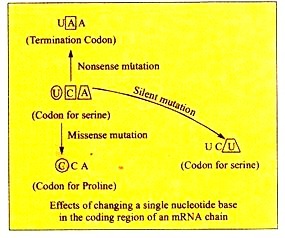The below mentioned article provides a short note on gene mutation.
Type of Gene Mutation:
An alteration in the sequence of bases in a gene due to change, removal or insertion of one or more bases in a gene resulting in an altered gene product is called mutation.
(a) Single Base Changes (Point Mutations):
It may be transitions or trans-versions.
In transitions, a given pyrimidine is changed to the other pyrimidine or a given purine is changed to other purine.
Trans-versions are changed from a purine to either of the 2 pyrimidine’s or the change of a pyrimidine into either of the 2 purines.
(b) Missense Mutation:
The codon containing the changed base may code for a different amino acid, e.g., if the serine codon UCA is given a different first base to become, say, CCA, it codes for a different amino acid, in this case, proline. The substitution of an incorrect amino acid is called a missense mutation.
(c) Nonsense Mutation:
The codon containing the changed base may become a termination codon, e.g., if the serine codon UCA is given a different second base to become, say, UAA, the new codon causes termination of translation at that point. The formation of a termination codon at an inappropriate place is called a nonsense mutation.
Genetic Information Flows from DNA to RNA to Protein:
i. The genetic information within the nucleotide sequence of DNA is transcribed in the nucleus into the specific nucleotide sequence of an RNA molecule. A number of different classes of RNA combine to direct the synthesis of proteins.
ii. In eukaryotic cells, the heterogeneous nuclear RNA (hn RNA) is much larger than the mature mRNA. The large hn RNA contains coding regions (exons) that will form the mature mRNA and long intervening sequence (introns) that separate the exons.
After the removal of introns by the processing of hnRNA within the nucleus, the exons are spliced to form mature mRNA which is translated into protein being transported to the cytoplasm.
iii. The cell possesses the machinery to translate information accurately and efficiently from the nucleotide sequence of an mRNA into the sequence of amino acids of the corresponding specific protein.
The nucleotide sequence of an mRNA molecule consists of a series of codons:
i. Transfer RNA (tRNA) molecules are the adaptor molecules that translate the codons into the amino acid sequence of a protein.
ii. The ribosome is the cellular machine to assemble the protein molecule. Ribosomes can assemble to translate a single mRNA molecule and form a polyribosome.
iii. The rough endoplasmic reticulum is a compartment of membrane—attached polyribosomes that provides for the synthesis of membrane proteins, Polyribosomal structures also exist free in the cytoplasm where they synthesize proteins that remain within the cell.
iv. Twenty different amino acids are required for the synthesis of proteins and there must be at least 20 distinct codons that make up the genetic code. In mRNA, there are only four different nucleotides and each codon must consist of more than a single purine or pyrimidine nucleotide.

